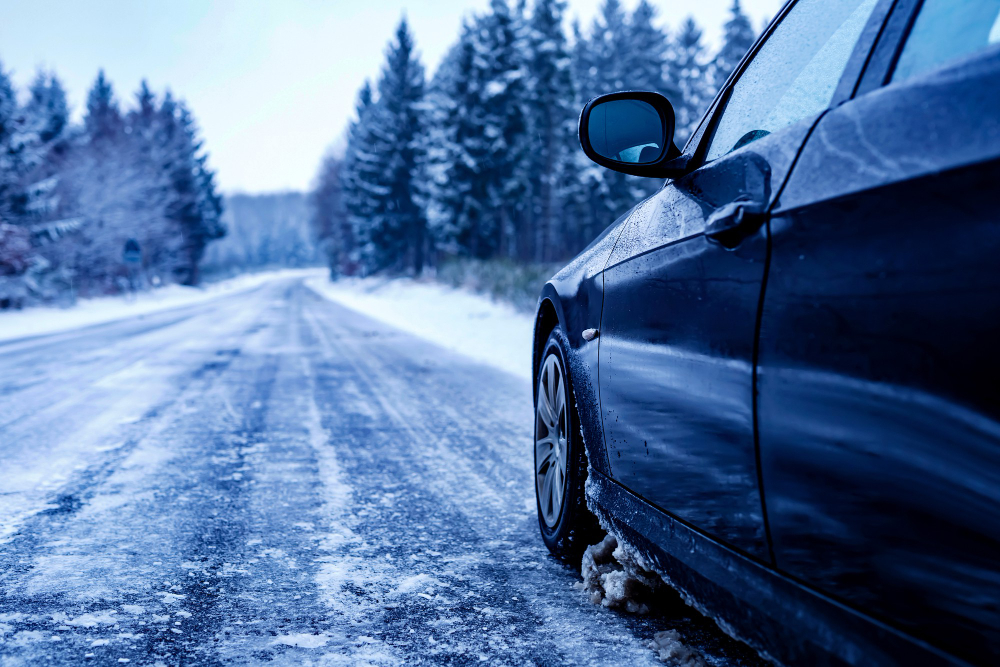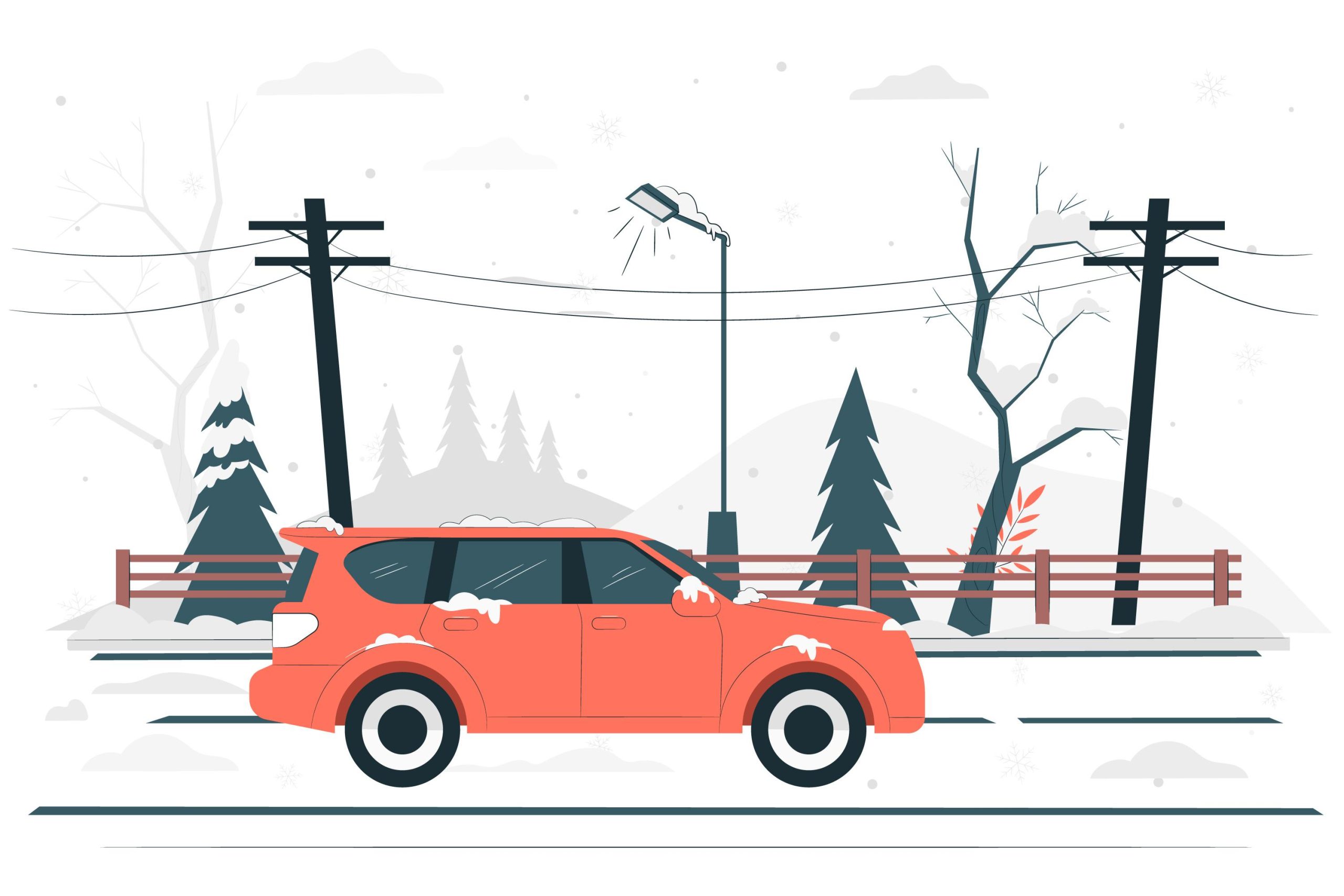Winter’s arrival transforms our daily drives into a journey through a frosty wonderland. But as the temperature dips, the challenges for our vehicles escalate. The icy roads and plummeting temperatures aren’t just hurdles for drivers; they’re a call to arms for every car owner. Winterizing your vehicle goes beyond cautious driving; it’s about embracing a thorough maintenance routine to keep your car dependable, efficient, and, most importantly, safe.
From ensuring optimal tire pressure to preparing emergency kits, these strategies are designed to shield your vehicle against winter’s harshness, ensuring a smooth and secure driving experience through the snowy months.
Tips to Maintain Car in Cold Weather

1. Regularly Check Tire Pressure
Tire pressure is known to decrease in lower temperatures, which can significantly impact your vehicle’s handling and fuel efficiency. It’s important to routinely check the pressure in all tires, including the spare, and adjust it according to the manufacturer’s recommended levels. Maintaining proper tire pressure is essential for optimal vehicle performance and safety. It ensures better traction on snowy or icy roads and can also help prevent tire wear and tear, prolonging the life of your tires.
2. Clear Snow and Ice from Your Car
Removing snow and ice from all parts of your car, including the roof, hood, trunk, and windows, is a critical safety step before starting to drive. Neglecting this can lead to snow or ice flying off your vehicle while driving, which is a serious hazard to other road users. Additionally, for vehicles equipped with modern technology like sensors and cameras, it’s crucial to keep these clear of snow and ice for them to function correctly. This ensures that your vehicle’s safety features operate effectively and you have unobstructed visibility.
3. Check Exhaust for Leaks
A fully functioning exhaust system is more important than ever in the winter, especially as vehicles tend to idle longer in colder weather. Regularly inspect your exhaust system for any leaks, as these can lead to hazardous exhaust fumes entering the cabin. This is not only a health risk but can also be fatal in enclosed spaces. Regular checks and timely repairs of the exhaust system are critical for the safety of all passengers.
4. Monitor Your Car’s Thermostat
The thermostat plays a key role in regulating your vehicle’s engine temperature. In winter, pay close attention to your car’s thermostat. Make sure the engine reaches and maintains the appropriate operating temperature. If you notice that the temperature gauge is reading lower than usual, or if the car isn’t warming up as it should, it might indicate a malfunction in the thermostat or cooling system. Such issues can affect your vehicle’s performance, fuel efficiency, and the effectiveness of the cabin heater.
5. Stay Informed on Recalls and Manufacturer Advice
Keeping up to date with any recalls or specific maintenance advice from your vehicle’s manufacturer is crucial for car safety and reliability. Manufacturers may issue winter-specific maintenance guidelines or recall notices that address potential safety issues. Staying informed and complying with these recommendations helps ensure that your vehicle remains in optimal condition and that any safety concerns are promptly addressed.
6. Lubricate Door and Window Seals
The rubber seals around car doors and windows can easily freeze in cold weather, leading to doors that are difficult to open or close. Regularly applying a silicone-based lubricant to these seals can prevent them from sticking and freezing. This simple maintenance task can save a lot of frustration and discomfort, especially on those chilly mornings when everything seems to freeze. It also helps in maintaining the integrity of the seals, ensuring they continue to provide proper insulation and protection against the elements.
7. Test Your 4WD System
If your vehicle is equipped with a four-wheel-drive (4WD) system, it’s crucial to ensure it’s in top working condition before the onset of winter. The 4WD system provides additional traction, which can be a game-changer in snowy and icy conditions. Regular testing and maintenance should include checking that the system engages and disengages smoothly and that all components are functioning properly. This not only gives you peace of mind but also ensures you have the added traction and control when you need it most.
8. Prepare an Emergency Kit
Winter driving can be unpredictable, and it’s wise to be prepared for any situation. Equip your vehicle with an emergency kit that includes essential items like blankets, a flashlight, water, and non-perishable snacks. Additionally, include a shovel and a bag of sand or kitty litter; these can be invaluable if you find yourself stuck in snow. This kit can be a lifesaver in situations like being stranded during a snowstorm or facing unexpected roadside emergencies. Being well-prepared can significantly reduce the stress and danger of winter driving mishaps.
9. Use a Block Heater in Extremely Cold Areas
In regions where the temperature drops significantly, a block heater becomes an invaluable tool for your vehicle. It’s designed to warm up the engine oil, which is especially beneficial for cold starts. The warmer oil improves lubrication during the initial start, reducing strain and wear on the engine. This not only aids in starting the car more efficiently but also helps the engine reach its ideal operating temperature quickly. Utilizing a block heater can extend the lifespan of your engine and is a smart move for maintaining your vehicle in frigid conditions.
10. Check Your Heating and Defrosting Systems
A robust heating and defrosting system is not just a comfort feature but a critical safety aspect in winter. Efficient heating ensures a comfortable and warm environment inside your car, which is vital in extreme cold. More importantly, a properly working defrosting system is crucial for maintaining clear visibility. It prevents the windshield and other windows from fogging up, which could otherwise obscure your view and increase the risk of accidents. Regular checks and maintenance of these systems ensure they function effectively when you need them the most.
11. Protect Your Car’s Exterior
Winter conditions can be harsh on your car’s exterior. The combination of low temperatures, ice, and road salt can lead to paint damage and rust. Applying a high-quality wax provides a protective layer, shielding the paint from these damaging elements. Additionally, regular car washes are essential in winter. They help remove road salt and grime, which can cause corrosion and paint damage if left unchecked. This routine care helps maintain the integrity and appearance of your car’s exterior throughout the winter season.
12. Examine Belts and Hoses
The cold weather can be particularly harsh on the rubber components of your car, like belts and hoses. These parts can become brittle and crack in low temperatures, leading to serious mechanical issues. Regular inspections for any signs of wear, such as cracks or fraying, are crucial. If you notice any damage, it’s important to replace these components promptly. Proactive maintenance of belts and hoses can prevent unexpected and costly repairs down the line, especially in the challenging conditions of winter when reliability is key.
13. Replace the Wiper Blades and Refill the Wiper Fluid
Maintaining clear visibility is vital during winter months when road conditions can be unpredictable. Wiper blades can wear out faster due to the ice and snow, causing them to lose their effectiveness. If they leave streaks or can’t clear the windshield properly, it’s time to replace them. Additionally, using a winter-grade windshield washer fluid that won’t freeze is essential. This special fluid can help to clear away the grime and salt that is common on winter roads. Keeping the wiper fluid reservoir full ensures you’re always prepared for whatever the road throws your way.
14. Keep Your Lights Clean and Functional
With shorter daylight hours and often dismal weather conditions, the functionality and cleanliness of your vehicle’s lights are critical. Dim or dirty lights significantly reduce visibility and can be a safety hazard. Regularly check all your lights – headlights, taillights, brake lights, and indicators – to ensure they’re working properly and are bright enough. Clean them frequently to remove any dirt, salt, or ice that could obscure their output. Good lighting is essential not just for seeing the road, but also to ensure other drivers can see you, reducing the risk of accidents in poor visibility conditions.
15. Keep the Gas Tank At Least Half Full
In winter, it’s a wise strategy to keep your gas tank at least half full at all times. This practice helps prevent the formation of moisture inside the tank, which can lead to frozen fuel lines in freezing temperatures, potentially disabling your vehicle. Moreover, a fuller gas tank adds extra weight to the vehicle, which can improve traction on slippery roads. It’s also a prudent measure for emergency preparedness, ensuring you have enough fuel to keep the car running in case you’re caught in unexpected delays or traffic due to winter weather conditions.
16. Check Your Antifreeze
Antifreeze, or coolant, plays a crucial role in your car’s health during winter. It prevents the water in your engine’s cooling system from freezing, which is essential for maintaining the engine at an optimal operating temperature. Ensure that your antifreeze level is sufficient and that you have the right antifreeze/water mixture, typically a 50/50 ratio, suited for your vehicle and the specific climate you are in. Regular checks for leaks or contamination in the cooling system are vital. A compromised cooling system in winter can lead to significant engine damage and costly repairs.
17. Inspect Your Brakes
Effective braking becomes even more crucial during winter due to icy and slippery road conditions. It’s important to have your brakes inspected professionally to ensure they are functioning correctly. This inspection should include a thorough check of the brake pads for wear, the condition of the rotors, the level and quality of brake fluid, and the overall performance of the braking system. Well-maintained brakes are key to safe driving, giving you better control and stopping power on winter roads. Regular brake checks can also help identify potential issues before they become serious, ensuring your safety and reducing the risk of accidents.
18. Battery Check and Care
In colder regions, your vehicle’s battery is under extra strain. Cold temperatures can significantly reduce its power output and efficiency. It’s essential to routinely test the battery for adequate charge and overall condition. Keep the battery terminals clean and free from corrosion to ensure maximum efficiency. Regular inspections for wear and damage are crucial, especially before the onset of winter. In regions experiencing extreme cold, opting for a battery with higher cold cranking amps (CCA) can offer improved starting performance, ensuring your car remains reliable even on the coldest days.
19. Switch to Winter Tires
Equipping your car with winter tires is crucial for safe winter driving. These tires are specifically engineered with unique tread designs and rubber compounds to provide superior traction on snow and ice. Before winter arrives, inspect your winter tires for adequate tread depth and signs of wear. Proper tread depth is critical for maintaining a good grip on slippery surfaces. Additionally, regularly monitor the tire pressure, as colder temperatures can cause a pressure drop, leading to decreased traction and reduced fuel economy. Keeping your winter tires well-maintained ensures safer handling and better vehicle performance in winter conditions.
20. Regular Oil Changes with Winter-Grade Oil
The viscosity of your engine oil plays a pivotal role in your vehicle’s performance, especially in cold weather. Winter-grade oils are formulated to flow more easily at lower temperatures, ensuring smooth engine operation and easier starts in cold conditions. Regularly changing your oil and using the correct winter-grade oil is vital for maintaining engine health. It reduces wear on engine components during cold starts and maintains optimal lubrication throughout the engine. This routine maintenance not only extends the life of your engine but also ensures it runs efficiently during the challenging winter months.
Conclusion
These regular checks and proactive measures are key to transforming your winter journeys from mere survival to confident, safe travels. Remember, effective winter car care is about preventative maintenance, a proactive approach that keeps you and your vehicle in harmony with the season’s demands. With these tips as your guide, embrace the winter knowing your vehicle is well-equipped to navigate the cold landscape with reliability and safety.
































































